|
The road that links Northgate End with Causeway is called, naturally enough, Linkway, though it remains the only road in Bishop’s Stortford without a nameplate to tell you so. Its construction in 1969/70 was part of the Town Redevelopment Scheme, and the cattle market, which stood at the corner of Northgate End, was reduced in size to accommodate it.
Waitrose supermarket was built in 1994 and stands on the original site of Hawkes & Co Brewery, established in 1780 (See Guide 6). Benskins Brewery bought out the company in 1898, and Ind Coope bought out Benskins in 1916. Between that date and January 1987, Ind Coope used the old brewery solely as a distribution depot, then sold part of the land to Waitrose in 1994.
Causeway car park and a large stretch of Linkway is bordered by Charrington House, former head office of fuel and transport group Charrington Gardner Locket & Co Ltd. This company's arrival in the town in 1973 was the direct result of a government incentive scheme that offered favourable rates and land prices to firms who relocated outside of London.
Work began on the building project in 1971, and apart from the railway it remained the largest single development ever built in the town until the Causeway redevelopment, 2005/7. The building's modernistic design is typical of the time, though the architect did try to be sympathetic to the town's historic past by incorporating turrets and a small buttress around the entire base of the building to reflect Waytemore Castle that once stood opposite. To some extent he succeeded, but its harsh lines of red brick and tinted glass curtain walls was totally alien to this market town at that time and locals irreverently dubbed it the ‘Fortress’ for all the wrong reasons. Surrounding trees have since softened the building’s starkness and prominence, but its design and presence is still the subject of much debate.
The Charrington group remained in Bishop’s Stortford for 26 years but relocated once again in 1999, this time to Buckinghamshire. East Herts District Council, who established their administration and some other main departments in the rear half of the building complex when it opened in 1972, are still in residence. Part of this, in Bridge Street, was refurbished and extended in 1999 to accommodate a new reception area.
|
|
When the Americans entered the Second World War in December 1941, US forces soon began arriving in Britain to help defeat the German occupation of Europe. Fundamental to this task was the construction of airfields in rural Essex and the first to arrive in this district was the 817th US Engineer Aviation Battalion. They began work on an air base at Stansted in August 1942.
The vast majority of these men lived and worked on the base, so to keep them happy when not on duty the American Red Cross established an entertainment centre at Bridge Street/Causeway on the site now occupied by Causeway car park and Charrington House. Built of wood and housing leisure facilities that included a small canteen/bar and dance hall, civilians were only allowed entrance with an American escort. This didn't cause too many problems on dance nights because trucks would be sent from the air base to pick up girls from the town and surrounding villages.
But by late 1943, as more and more American forces arrived in the district prior to Stansted air base becoming operational in February 1944, it was obvious the Red Cross Centre at Bridge Street/Causeway would be far too small for requirements. Work then began on building a much larger American Hostel on the same site.
Photographic evidence of the hostel is hard to find but a brief report in the Herts & Essex Observer, dated 8 January 1944, does record its opening and gives a good description of facilities:
New American Hostel – Stortford Canteen For US Troops
A hostel and canteen for American troops, with facilities of a first-rate hotel, has been opened this week at the Causeway Bishop's Stortford. There is accommodation for 300 'residents' with two large public lounges, reading room, dining room, barber's shop, tailor's shop and shower rooms. In case anyone is taken ill a First Aid room has also been provided, with sleeping arrangements too.
The whole hostel is a triumph in organisation for Mr Hugh C Foster (club director) who has been responsible for one of the finest troop clubs seen in this country.
The premises are centrally heated throughout and all rooms decorated in cream, yellow and green with contrasting black polished floors. Armchairs are upholstered in folk weave fabric and there are curtains of similar material.
A large staff contributes to the smooth running of the club, from Miss Dean, the catering manager, to 'Rusty' the chef, who produces excellent meals, sandwiches, snacks and his famous 'hot dogs.' There are pleasant helpers who take care of reception, information, soap and towels and so on. The club has proved so popular with the troops this week that on some nights it was difficult to persuade them to leave their comfortable reception rooms and go to bed.
After the war the hostel was taken over by the Education Authority for use as a school to relieve the burden on Stortford's existing schools, especially nearby Northgate End (See Guide 7). It became in fact the town's first coeducation secondary modern school, catering for children aged 11–15.
Taking the shape of a rectangle, thereby forming an inner quadrangle, the single-storey building was converted to accommodate about ten classrooms with two larger ones used for woodwork and metalwork lessons. Buildings were constructed of large raw bricks, which were left un-rendered, and roofed with either asbestos or corrugated iron. But the buildings were centrally heated! Also on the site, former Anderson shelters were used for storage.
Despite being termed 'coeducational', boys and girls were still segregated. In classrooms the boys sat on one side and the girls on the other, and at playtimes the girls used the small quadrangle while boys played on an outer tarmac area.
The school had no playing fields of its own so for football the boys had to walk to a field at the top of Parsonage Lane where Birchwood High School now stands. In summer, girls played netball in the quadrangle but all other sports took place at Sworders Field near the bottom of Hockerill Street.
By the mid 1950s the school is said to have accommodated up to 500 pupils and remained coeducational until 1957, by which time the Boys High School had been built at London Road. It then changed to single sex education and was re-named the Bishop's Stortford Secondary Girls School – or as pupils affectionally termed it, the Causeway Academy!
The school finally closed in the mid 1960s when the new Margaret Dane girls school opened at Parsonage Lane (See Birchwood High School – Guide 10). Demolition took place soon after and in 1971 groundwork began on the site for construction of Charrington House.
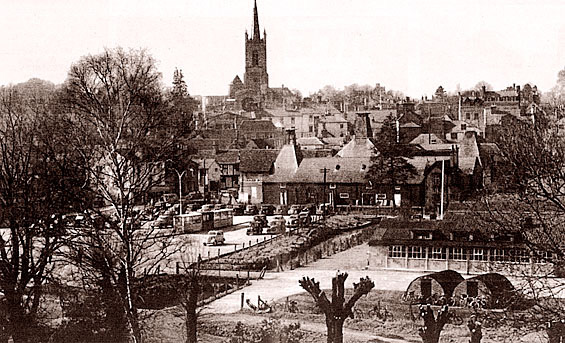
To the right in this photograph, taken from the Castle mound probably in the early 1950s, can be seen the former American Hostel that by this time had become Causeway Secondary school. A flagpole can be seen in the middle of the school buildings from which the American flag no doubt once flew, and in the foreground two large Anderson shelters remain from the war years. Judging by the number of bicycles seen leaning against them, they may well have been used by pupils as bike sheds. To the left of the picture it's clear that land (now occupied by Charrington House) was already in use as a car park. The site of the school itself is now Causeway car park. Not visible in the picture is the river Stort that ran between the school and the former malting behind it (now Coopers) but very noticable is a fenced water course between the parked cars and the school buildings. This may well have been a natural tributary of the Stort but its course looks as though it has been engineered and then contained. A bridge crosses the water course allowing access to and from the school. At that time, of course, Linkway hadn't been constructed and so the field in the foreground, at the foot of Castle mound, stretched uninterupted as far as the school.
Photograph is courtesy of former Causeway School pupil, Dave King.
Former Bishop's Stortford resident Norma Clare (nee Tuck) has been kind enough to record for me her childhood memories of time spent at Hockerill Practising School (1944 – 1950) and at Bishop's Stortford Secondary Modern School (1950 – 1954).
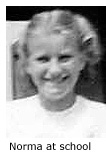 Aged five my school life began at Hockerill Practising School, once part of the Teachers Training College at Dunmow Road. This was attended by boys and girls but at the age of seven the boys left to be taught at All Saints (parish) Hall in London Road, also known as Hockerill Boys School. This arrangement continued until 1957 when the Boys High School was built in London Road. I know the hall was still in use for social functions in 1959 because my wedding reception was held there, but it was demolished in the early 1960s. Aged five my school life began at Hockerill Practising School, once part of the Teachers Training College at Dunmow Road. This was attended by boys and girls but at the age of seven the boys left to be taught at All Saints (parish) Hall in London Road, also known as Hockerill Boys School. This arrangement continued until 1957 when the Boys High School was built in London Road. I know the hall was still in use for social functions in 1959 because my wedding reception was held there, but it was demolished in the early 1960s.
Perhaps my most vivid memory while attending Hockerill Practising School was lunchtimes spent walking in a 'crocodile' procession down to the Civic Restaurant in the town. This large building sited between South Street and the river, approximately where the rear entrance of the former Sainsbury's store was in Riverside, had originally been the British restaurant. This was a generic name given to many such restaurants built throughout the country during the Second World War to supply affordable meals for those who had been bombed out and for the not so well off.
There we were made to eat whatever was put on our plate and although I knew haricot beans would make me throw up, I was still made to eat every one. And sure enough I later saw them all again! The best story about these meals was when our Nature teacher Miss Close accompanied us. In my cabbage one day was a large green creature. I called Miss Close over and told her there was a caterpillar in my cabbage. She looked at it closely and said 'It's not a caterpillar, it's a chrysalis' and walked away!
Girls remained at Hockerill Practising school until the age of eleven; those who passed their Eleven Plus exam going on to Grammar school and those that didn't going to Bishop's Stortford's very first coeducational secondary modern school in the Causeway. The same applied to boys who were taught at All Saints Hall. I went to Causeway secondary modern from 1950 until 1954.
The 'new' secondary school was in fact the former Rest Centre of the American Forces that were stationed in the area during the war and was built about 1942. After the war it was converted for use as a school to cope with the town's growing child population. Most children that attended the school were from Stortford but there were some who came from Spellbrook and Sawbridgeworth. The school certainly wasn't grand but to us children it was just fine and at least we didn't have to walk into town anymore for our lunch. Having its own kitchen (previously used to feed the Americans) the vast majority of pupils stayed for school dinners. Those that didn't went home for lunch.
One of them was a girl called Coral Chapel, and I vividly remember the day she came back to school after lunch and told everyone that the King was dead. Lots were saying it wasn't true and that she shouldn't say such things. Shortly afterwards we were all summoned to a special assembly and told that the King was indeed dead and that we would now sing the national anthem, remembering it was God Save the Queen. So we all stood up and sang. We had all learnt it parrot fashion and sang it every day so we didn't think much about the words. On this occasion we sang 'Queen' but we also sang 'send 'im victorious'.
For the first two years of my time spent at the Causeway school, boys and girls sat in mixed classrooms for every subject. I enjoyed science in the first two years and was always near to the top of the class but was not allowed to do it when we went into the third year – it was for boys only. We had to do Biology and learn about plants, which I was not very happy about! We were still mixed for Maths, English, French and all other subjects that were not 'boyish or girlish'.
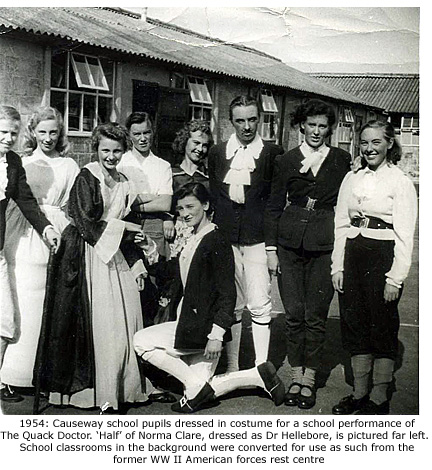 Despite boys and girls being able to sit together for lessons, we were segregated at playtime. The girls played in the quadrangle formed by the position of the classrooms around it, and the boys played on a tarmac area outside of this. They were also allowed to play football on the grass area that surrounded the school. The structure of the buildings made a ledge all round the girls playground and one silly thing we all did was try to walk on this ledge all the way round without touching the ground. In some parts it was very easy but in others you had to hang on and then stretch or jump to the next bit. It seemed like fun at the time. We also played ball games. Despite boys and girls being able to sit together for lessons, we were segregated at playtime. The girls played in the quadrangle formed by the position of the classrooms around it, and the boys played on a tarmac area outside of this. They were also allowed to play football on the grass area that surrounded the school. The structure of the buildings made a ledge all round the girls playground and one silly thing we all did was try to walk on this ledge all the way round without touching the ground. In some parts it was very easy but in others you had to hang on and then stretch or jump to the next bit. It seemed like fun at the time. We also played ball games.
There were also school trips and I particularly remember a trip to Windsor Castle in 1953 where I took my first photograph of the castle. But the best trip of all was when we went camping at Cuffley in July 1954. Needless to say I also have photos of that adventure. The funny thing about the Cuffley trip was that I and a couple of other girls were bad travellers and were allowed to travel back home in the teacher's car instead of the coach. But his car wasn't big enough for our kitbags so they went on the coach. The teacher's car kept breaking down and we didn't get back to the school until a couple of hours after the others. The coach driver had just dumped our baggage on the ground and it was all still there when we arrived! Can you imagine that happening today?
Pupils left the school at the age of 15. In fact we left at the end of the term when we had our 15th birthday. My birthday was in June so I stayed until the end of the academic year. I liked school so I didn't mind that at all. Some of my class had left the previous Christmas and some at Easter. Some went on to further education but it wasn't an option that I was offered so I left a couple of weeks after my 15th birthday, took one week off and started working as a cashier the following week.
Also read Norma's childhood memories of her time spent at Dimsdale Crescent – Guide 10, Memories page
|

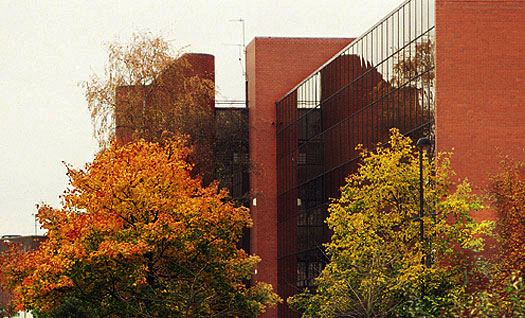

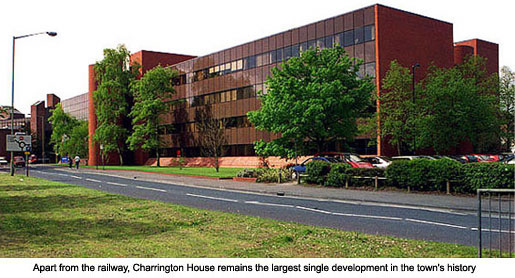



 Aged five my school life began at Hockerill Practising School, once part of the Teachers Training College at Dunmow Road. This was attended by boys and girls but at the age of seven the boys left to be taught at All Saints (parish) Hall in London Road, also known as Hockerill Boys School. This arrangement continued until 1957 when the Boys High School was built in London Road. I know the hall was still in use for social functions in 1959 because my wedding reception was held there, but it was demolished in the early 1960s.
Aged five my school life began at Hockerill Practising School, once part of the Teachers Training College at Dunmow Road. This was attended by boys and girls but at the age of seven the boys left to be taught at All Saints (parish) Hall in London Road, also known as Hockerill Boys School. This arrangement continued until 1957 when the Boys High School was built in London Road. I know the hall was still in use for social functions in 1959 because my wedding reception was held there, but it was demolished in the early 1960s. Despite boys and girls being able to sit together for lessons, we were segregated at playtime. The girls played in the quadrangle formed by the position of the classrooms around it, and the boys played on a tarmac area outside of this. They were also allowed to play football on the grass area that surrounded the school. The structure of the buildings made a ledge all round the girls playground and one silly thing we all did was try to walk on this ledge all the way round without touching the ground. In some parts it was very easy but in others you had to hang on and then stretch or jump to the next bit. It seemed like fun at the time. We also played ball games.
Despite boys and girls being able to sit together for lessons, we were segregated at playtime. The girls played in the quadrangle formed by the position of the classrooms around it, and the boys played on a tarmac area outside of this. They were also allowed to play football on the grass area that surrounded the school. The structure of the buildings made a ledge all round the girls playground and one silly thing we all did was try to walk on this ledge all the way round without touching the ground. In some parts it was very easy but in others you had to hang on and then stretch or jump to the next bit. It seemed like fun at the time. We also played ball games.